Oyako-don is a quick and easy dish that is low cost and filling. Perfect for the working mum with young growing kids. I was exactly like that many years ago. If you add some salad and miso soup to accompany it, it will become a simple but great weekday meal.
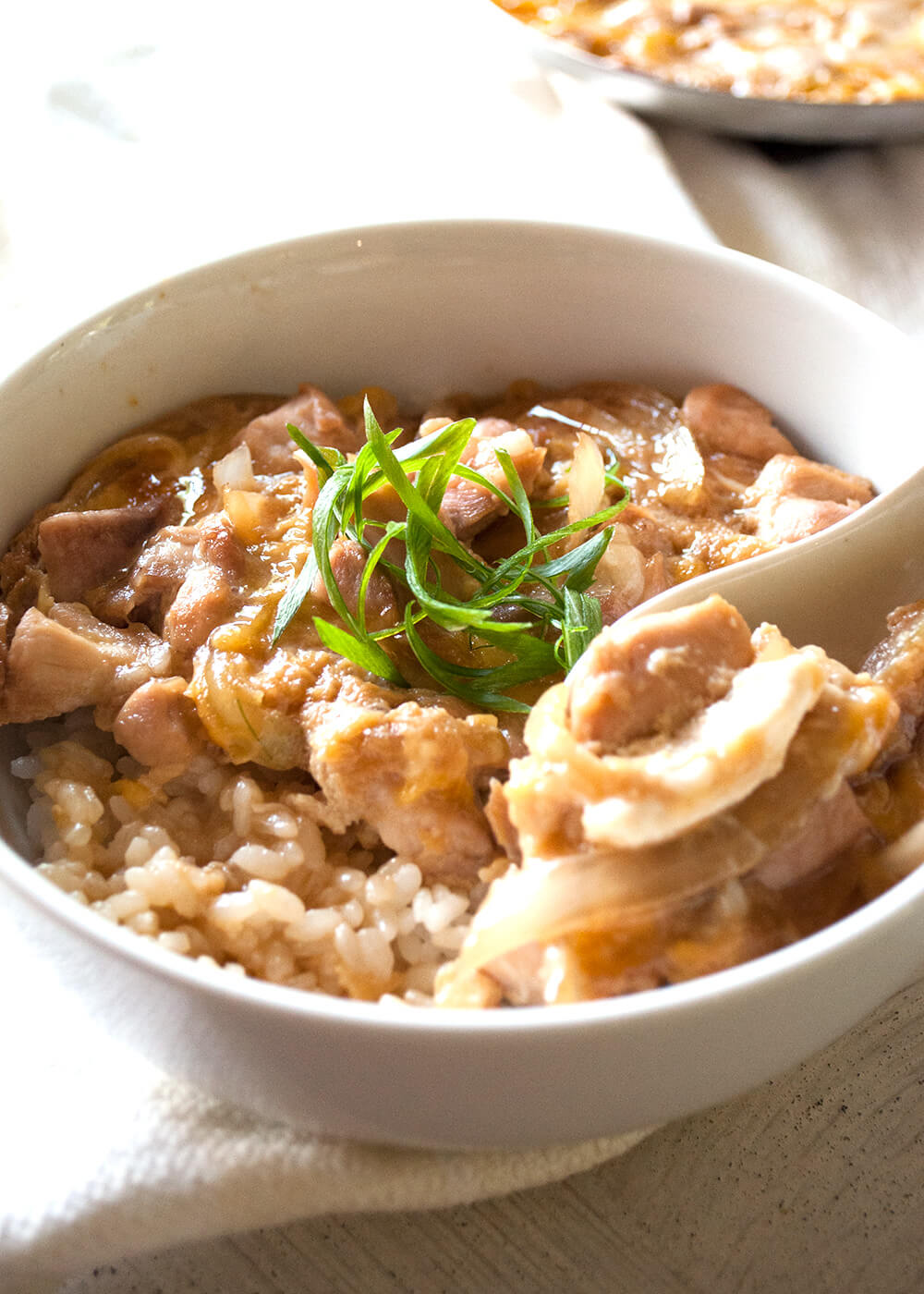
The word ‘oyako’ (親子) means parent and child in Japanese. The main ingredients of this dish are chicken and egg so you go and figure out where the name came from.
‘Don’ (丼) is a shortened form of the word ‘donburi’ (丼ぶり) which means pottery and porcelain bowls. Donburi are larger than rice bowls. Because this dish is served in a donburi with rice in it, it has ‘don’ at the end.
Oyako-don (or Oyako-donburi) is quite popular but there are other popular donburi dishes such as ‘katsu-don’ (カツ丼, pork cutlet with egg on rice), ‘ten-don’ (天丼, tempura on rice), ‘una-don’ (鰻丼, cooked eel on rice), and ‘tekka-don’ (鉄火丼, tuna sashimi on rice). I am hoping that I will be able to share some of these donburi dishes in future.
Ideally, you want to cook oyako-don individually in a small pan but at the same time so that everyone gets served a hot dish, with a perfect circular shape of topping in a bowl, all at once. But this would be a challenge for you unless you have the same number of small frypans and burners as diners.
I am fortunate enough to have a couple of special pans made just for the donburi dishes. With the addition of a small frypan, I could make 3 individual oyako-don at once. See the photo of the special pan below.
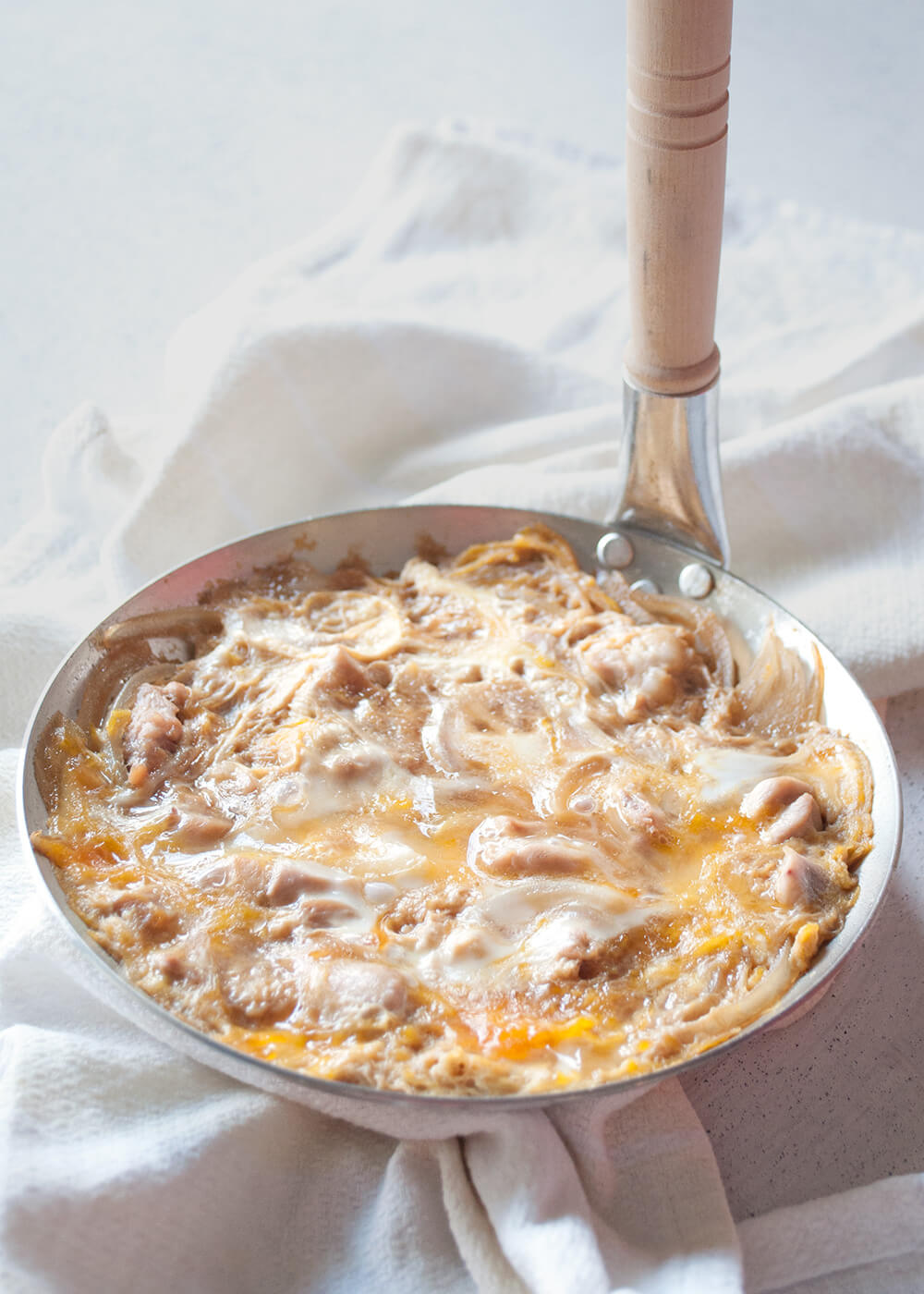
This special pan is called ‘oyako-nabe’ (親子鍋, oyako-pot/pan). Oyako-nabe has the right sized surface area to just fit the topping onto the rice in a donburi. It also has a wooden handle vertically attached to the pan for easy handling when transferring the topping onto the rice. In Sydney, you can buy oyako-nabe at Tokyo Mart in Northbridge.
When my children were young, we were family of 5 and we could not make 5 individual serving at once. So, I used a large fry pan and cooked it all in one go, then divided it into 5 pies like slicing a pizza.
In this recipe, I have included two instructions – making oyako-don individually and making it in a large frypan and dividing up the topping.
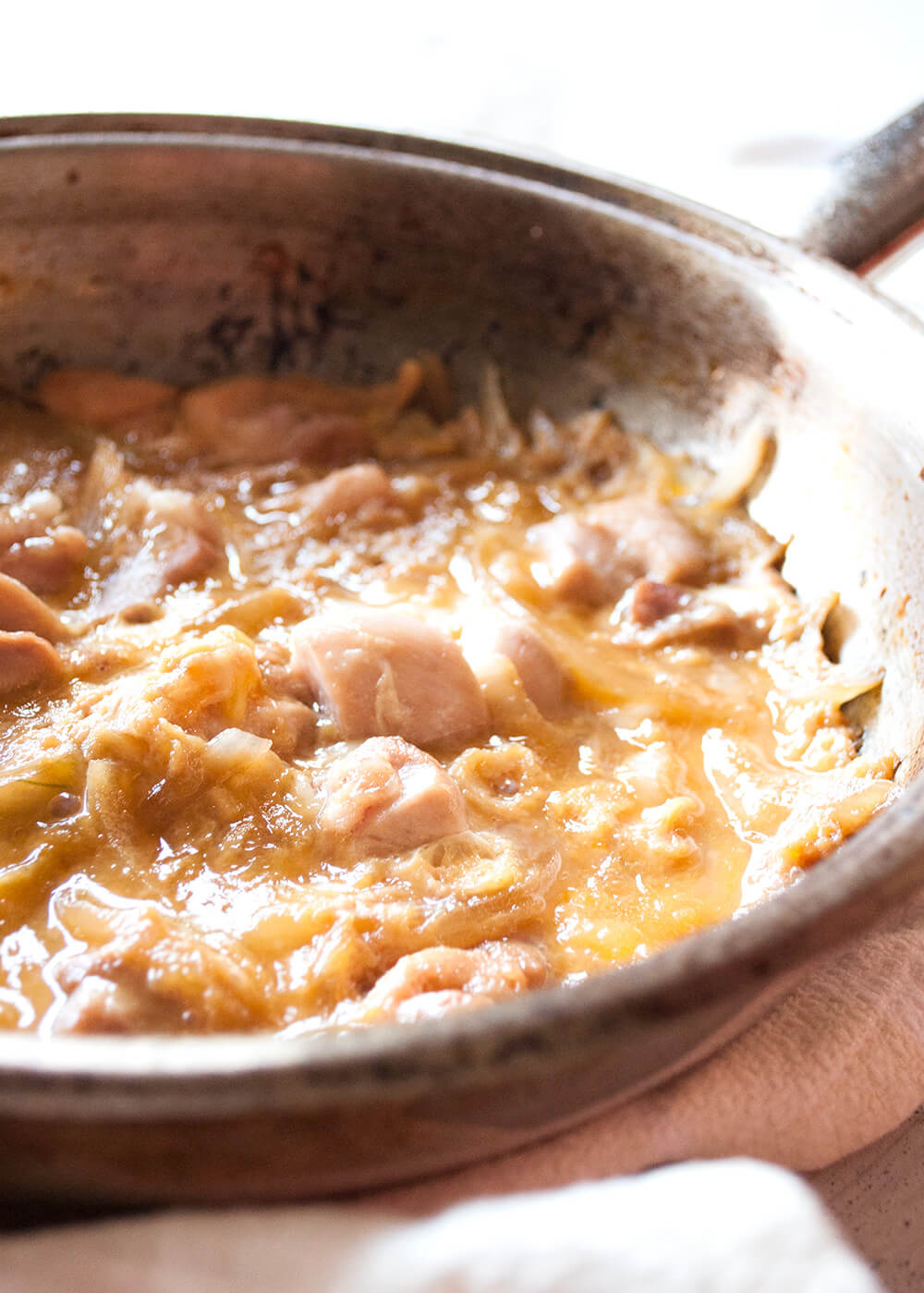
Donburi dishes are popular among families who have growing children as they are low cost, fast to cook and delicious. Among the various donburi dishes I listed earlier, oyako-don is the most balanced from a nutrition perspective and the fastest to cook along with gyu-don if you are making the toppings from scratch. You can understand why it is popular.
Fast food restaurants often offer oyako-don and you will notice that the egg in the oyako-don topping is often half cooked. You can see uncooked egg here and there on the surface of the topping. But the egg in my oyako-don is well cooked. This is because I am not fond of the texture of raw egg. I even prefer fried egg with well cooked egg yolk. But, when I eat sukiyaki, I use raw egg to dip. I know, I am inconsistent.
If you like the egg to be semi-cooked, you reduce the cooking time after adding the egg. You just need to experiment and find the best timing to turn off the heat.
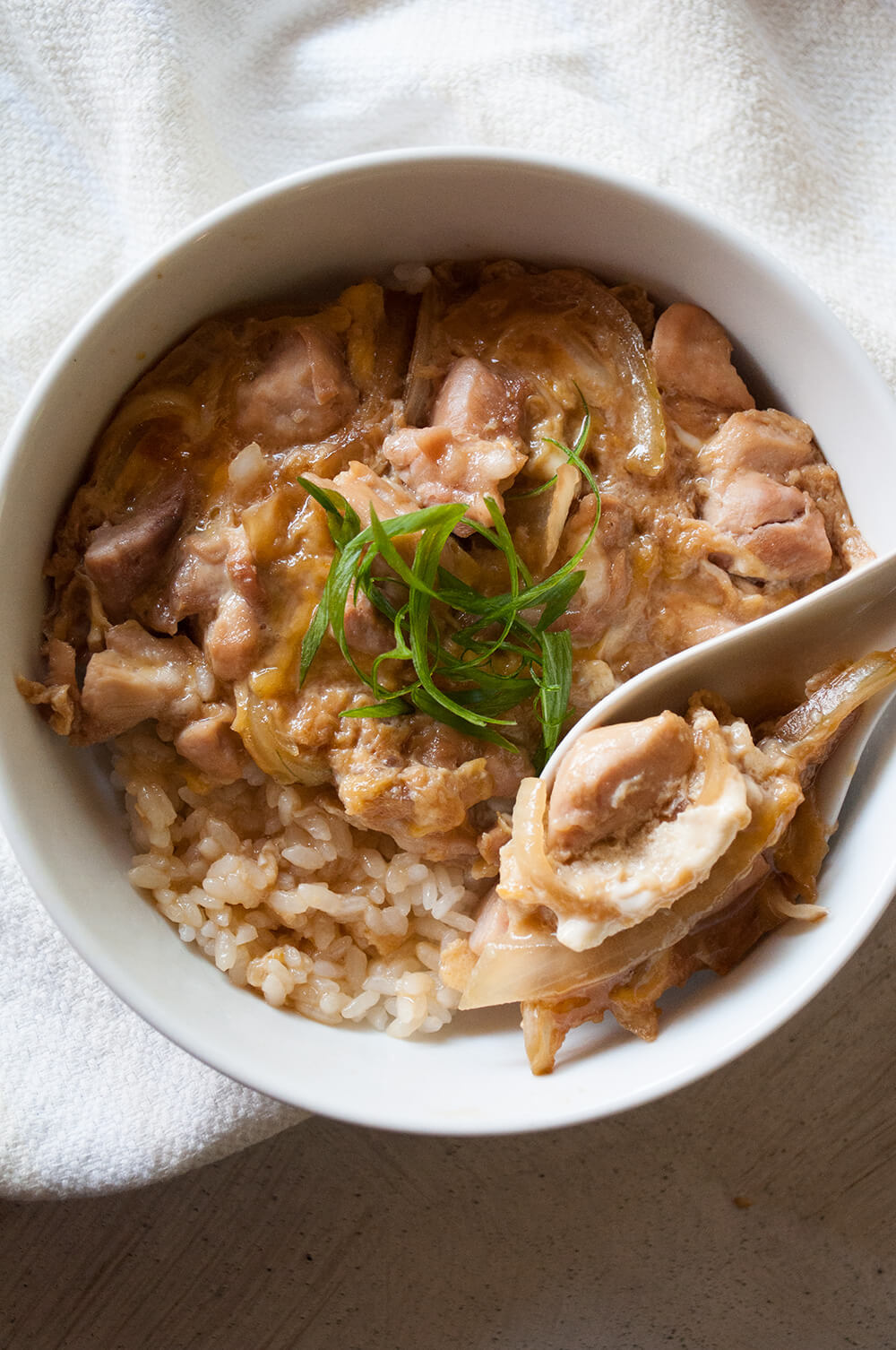
Yumiko![]()
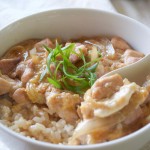
- 250g (0.5lb) thigh fillets , cut into bite size pieces (note 1)
- ¾ onion sliced
- 6 eggs
- 150ml (5.1oz) dashi stock (please refer to Home Style Japanese Dashi Stock)
- 105ml (3.6oz) mirin
- 45ml (1.5oz) soy sauce
- 3 bowls of cooked rice (hot)
- Julienned green part of shallots (optional)
-
Mix sauce ingredients in a large measuring cup/jar. Add 1/3 of the sauce into a small frypan of about 18-20cm (8") in diameter over medium heat (note 2).
-
When the sauce starts boiling, add 1/3 of chicken and onion spreading randomly. Stir occasionally and cook for few minutes until chicken is almost cooked (note 3).
-
Beat 2 eggs, add ½ of it into the pan and mix gently. When the egg is cooked through, spread the remaining egg over the cooked chicken and egg in the pan.
-
Cover the pan with a lid or use a larger pan with a flat bottom to cover the pan and cook for 30 seconds to 1 minute until the egg on the surface is nearly cooked but slightly runny (note 4). By then, you should have a small amount of sauce still left at the bottom.
-
Turn the heat off. Using a spatula, slide the cooked chicken and egg over the rice, covering all of the rice. Garnish with shallots.
-
Repeat for other two bowls.
-
Add all the sauce ingredients to a large frypan over medium heat (note 2).
-
Follow the same process as per individual cooking method using all the ingredients at once. Note that time required to cook chicken and egg will be a bit longer.
-
After turning off the heat, divide the chicken and egg into three pies using a spatula. Then slide each pie onto the bowl of rice. Tidy up the edges to make the topping fit in the bowl. Garnish with shallots if using.
1. I used thigh fillets without skin on. I prefer thigh to breast meat but you can use breast fillets or tenderloin if you prefer. The texture of the meat will be different.
2. If you can find 3 small frypans and 3 burners, then I would suggest that you cook 3 servings at once. Luckily, I have a couple of special pans for this kind of meal. So I make 3 servings at once.
If you are making it all in one pan, you won’t be able to make individual portions in a perfect circle. But don’t worry. You can easily shape the edges to fit in the bowl and nobody will know.
3. The time taken to cook the chicken varies depending on your definition of ‘bite size’. In this recipe, I cut the meat into 2-2.5cm (3/4-1") cubes.
4. I like the egg to be only slightly runny as raw egg is not my best friend. And if you cook it through, it will become dry. But it is up to your liking.
Thank you Yumiko for an easy and really tasty recipe. My kids love this and I always have to cook extras for them cos they will ask for seconds and thirds!
Hi Tunadip, that’s great! My kids love Ayako-don too.
This is excellent. First time is used a dashi sachet rather than making my own homemade and I have enough of the mixture to have it two more times this week. A lot more accessible than making the pork katsu and the homemade dashi. Thank you for making a dish I love a go to dinner!
Hi Joanne, dashi sachets are quite convenient aren’t they?
Hello yumiko, I have to say that this is one of my favorite Japanese recipes, simple but delicious. But I noticed that the pan that I used is very small, so I wonder more or less what diameter has oyako-nabe ?, next time I will use a pan of approximate size.
Thank you for the recipe
Hi Ruth, my oyako-nabe is about 18cm (7″) in diameter. If you use 10-20cm (7-8″) pan, it should work well.
Hi Tin!
I used this recipe for the sauce to make a vegetarian don and it was really good! I’ll have to try your full recipe next time 🙂
Hi Susan, I am pleased to know that the sauce taste good even without meat. Thanks for letting me know.
Hello Yumiko and Nagi…
Since I came across to Nagi’s recipes in one of the food magazine, I have been trying both of your recipes almost every week. I always plan my menu for the week and love to try new meal on dinner table for my family. So…thank you very much.
-ingka-
Hi Ingka, you are most welcome. Thanks for trying our recipes!
hi!
came across your shumai recipe in facebook today and delve into your site soon as i get in the office. great site! will definitely try your shumai and kakiage as a kick off.
keep posting!
Thank you! Good choice for a kick off!
hello send me some recipes with video this is easy way to learn
Hi, I am sorry but I am not yet equipped to do video without Nagi’s help. But I will try to include step by step photos when I cannot do video.
Just made this for a quick meal tonight and it turned out great! My husband particularly enjoyed it and asked me to make it again soon. It will be easy to make on a busy weeknight and has only a few ingredients that are staples around my house. Thank you for the recipe, I am putting in into my regular rotation!
Hi Ashleigh. I am glad that it made to your regular rotation. Thank you very much for that!
Great recipe! I remember it’s the first dish I’ve ever had in a Japanese restaurant when I was young very. My mom and I both ordered it for the sake of its name. Now it brings back a lot of nostalgia!
Food often brings back good memories, doesn’t it? You can now make it for your mom!
I really like this recipe…looking forward to making it…Your Oyako-nabe pan is adorable!
Thank you! I hope you like it!